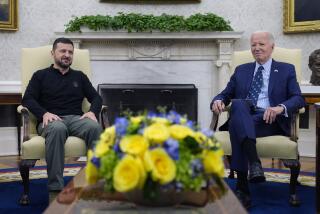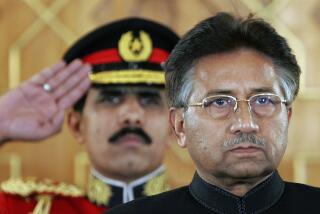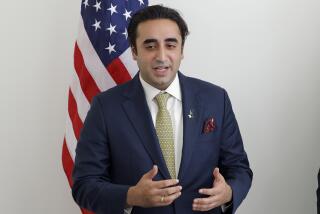Pakistan fails to aim billions in U.S. military aid at Al Qaeda
- Share via
WASHINGTON — Despite billions of dollars in U.S. military payments to Pakistan over the last six years, the paramilitary force leading the pursuit of Al Qaeda militants remains underfunded, poorly trained and overwhelmingly outgunned, U.S. military and intelligence officials said.
Pakistani President Pervez Musharraf cited the rising militant threat in declaring a state of emergency on Saturday and suspending the constitution.
But rather than use the more than $7 billion in U.S. military aid to bolster its counter-terrorism capabilities, Pakistan has spent the bulk of it on heavy arms, aircraft and equipment that U.S. officials say are far more suited for conventional warfare with India, its regional rival.
That has left fighters with the paramilitary force, known as the Frontier Corps, equipped often with little more than “sandals and bolt-action rifles,” said a senior Western military official in Islamabad, even as they face Al Qaeda and Taliban fighters equipped with assault rifles and grenade launchers.
The arms imbalance has contributed to Al Qaeda’s ability to regroup in the border region, and reflects the competing priorities that were evident even before this weekend between two countries that are self-described allies in the “war on terrorism” but have sharply divergent national security interests.
The situation also has emerged as a significant obstacle as the United States and Pakistan seek new approaches after a series of failed strategies in the frontier region, where Osama bin Laden and other top Al Qaeda leaders are believed to be hiding.
U.S. officials have urged Pakistan to move more aggressively against militants and bolster the capabilities of the Frontier Corps, an indigenously recruited force of about 80,000 troops, half of them based in the tribal areas, that was formed under British rule and is traditionally used to guard the border and curb smuggling.
Even front-line units with upgraded weapons are woefully unschooled in counterinsurgency tactics, other officials said. Late last month, Islamic militants captured dozens of fighters and paraded them before Western journalists, the latest in a series of embarrassing encounters.
Pakistan has recently indicated that it will enlarge the corps and expand its role in pursuing Al Qaeda. But because the Frontier Corps has been all but shut off from U.S. military aid and payments to Pakistan, U.S. officials said the new strategy amounts in some ways to starting from scratch more than six years after the Sept. 11 attacks.
“The view in Washington is that the Frontier Corps is the best way forward because they are locally recruited, speak the language, and understand the culture, terrain and local politics,” said a senior Pentagon official, discussing internal deliberations on Pakistan policy on condition of anonymity.
But transforming the corps into a force that can contend with militants in the tribal area “will take years to bring to fruition,” he said.
Partly because of that timetable, the goal of dismantling Al Qaeda and its hub of operations in the border region has given way to expectations among U.S. intelligence and military officials that the United States and Pakistan face a years-long struggle simply to contain the terrorist network and keep it from expanding.
“I think it’s worse than starting from scratch,” said Bruce Riedel, a former South Asia expert at the CIA and the White House now with the Brookings Institution’s Saban Center for Middle East Policy.
“The most optimistic of scenarios we’re looking at is a very long-term effort to try to stabilize the badlands of northwestern Pakistan,” Riedel said. “The alternative is . . . a more or less permanent Taliban state within a state in northwest Pakistan.”
Plans to build up the Frontier Corps are not universally supported by U.S. military officials. Loyalties within the corps are thought by many observers to be divided. Members are recruited mainly from Pashtun tribes with long-standing mistrust of outsiders. Most reject militant ideology, and have suffered hundreds of casualties in the fighting. But many also are devoutly religious and feel some degree of sympathy for the Islamists’ cause.
“There is a push-back among some that the Frontier Corps is not a reliable ally of the United States,” said Seth Jones, a military expert at Rand Corp. “The concern is that you give them additional training and equipment, and they could end up helping militants rather than taking action against them.”
Perhaps as a hedge against those concerns, the U.S. Special Operations Command has recently begun exploring efforts to pay off tribal militias in the region that are not affiliated with the Pakistani government, and arm them to root out Al Qaeda and Taliban militants, a source familiar with the discussions said.
“You can’t buy them, but you can rent them,” said the source, who spoke on condition of anonymity because of the sensitive nature of the discussions. “There is a very serious effort to look at this.”
The CIA also operates in the area, and has doubled the number of case officers based in Pakistan in recent years, former agency officials say.
Despite the concerns, U.S. officials said there is widespread agreement that boosting support to the Frontier Corps is worth the risk, a position that reflects deep frustration with a string of failed strategies in the border region.
An early failure was a plan to keep Al Qaeda operatives from crossing into Pakistan when U.S. troops invaded Afghanistan in late 2001. That was followed by ineffective forays by thousands of Pakistani regular army troops and aborted peace agreements with tribal leaders who did not fulfill pledges to clamp down on the militants.
By last summer, U.S. intelligence agencies concluded that the peace deals had given Al Qaeda room to regroup and rebuild its ability to train and plan attacks on Western targets.
Under new pressure from the United States, Musharraf resumed military incursions earlier this year, with Frontier Corps fighters teaming up with Pakistani regular army units. The effort produced a series of bloody and clumsy confrontations that may have strengthened the militants’ position in the tribal areas.
Especially demoralizing was the Aug. 30 capture of about 250 troops, most of them members of the Frontier Corps, who surrendered without a fight. Over the next two months, a few dozen were released but at least three were beheaded. Over the weekend, 211 were freed in exchange for 25 militants held by the army.
Taking on Al Qaeda and Taliban militants represents a significant departure for the Frontier Corps, whose members are typically outfitted with castoffs from the regular army. Led by army officers who often disdain the assignment, Frontier Corps units have obsolete artillery pieces, have to travel by foot because they have no ground transport, lack night-vision equipment, and have almost no air power.
“Yesterday they had one helicopter operating,” a senior Western diplomat in Islamabad said during a recent interview. “If they had two, it was a good day.”
Reluctant to offend a crucial ally, the United States has placed few conditions on the military aid, part of a larger package of U.S. aid and payments totaling more than $10 billion. As a result, Pakistan used much of it to acquire big-ticket weapons systems and other items to shore up its conventional defense capabilities, U.S. officials said.
The Defense Security Cooperation Agency, which oversees U.S. weapons transfers, said that shipments to Pakistan since the Sept. 11 attacks had included some equipment that could be useful in pursuing militants in the tribal areas, including 4,000 radios and 12 refurbished attack helicopters. But even those items went to the regular army, the agency said, and are unlikely to be shared with the Frontier Corps, which falls under a separate branch of the Pakistani government.
The majority of Pakistan’s purchases have been of items that would be difficult to deploy in counterinsurgency fights, including harpoon missiles designed to sink warships, F-16 fighter jets, maritime surveillance aircraft and refurbished howitzers that have to be towed into position.
“It’s hard to make arguments that the bulk of what is being provided by the U.S. is very effective for counter-terrorism operations,” said Alan Kronstadt, a specialist in South Asian affairs at the nonpartisan Congressional Research Service. “A lot of the military assistance has been much more useful for a potential war with India.”
Musharraf’s emergency declaration could force a review of U.S. aid, a move Democratic lawmakers said Sunday they would support.
The U.S. and Pakistan have spent part of the last year developing what one Pentagon official described as a “multiyear plan” to bolster the Frontier Corps’ capabilities, U.S. officials said.
Pakistan has already begun recruiting more troops, with plans to expand the corps to 100,000. U.S. funding would help pay for the increase, as well as a training center that will focus on counterinsurgency tactics.
The Pentagon has budgeted $55 million in counter-narcotics funds for the Frontier Corps this year to pay for night-vision equipment and communications gear. But the Pentagon is also seeking additional funding in a separate category that could be used for weapons. Officials declined to discuss specifics.
“It’s nothing really sexy,” said the senior Pentagon official involved in Pakistan policy. “But they need to be at least on par with the militants.”
--
Times staff writer Laura King in Islamabad contributed to this report.
More to Read
Sign up for Essential California
The most important California stories and recommendations in your inbox every morning.
You may occasionally receive promotional content from the Los Angeles Times.










